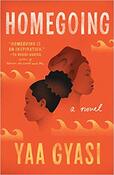Sacred Chickens
Menu
SACRED CHICKENS
 Expansive in scope and plot formation, Homegoing details the stories of two sisters separated at birth on the Gold Coast, which is modern day Ghana. It follows them and their descendants, and tells the story of slavery, the horrors of a plantation, the abolition of slavery and how new forms of slavery took its place, the crack epidemic of the 80s, all the way up to the present day. The story begins when a mother starts a fire to save herself and her daughter. Throughout the novel, we see examples of just how far the mothers in this story, many of whom were slaves but not all, will go to save their children. We see mothers in impossible situations, where speaking out or rebelling means death, still they try to make sure their children are safe. T Various types of mothers – some abusive, some who killed their child, some who sacrifice their own lives for a child’s freedom, mothers who were trying to survive in abominable conditions – are the foundation of this novel. Gyasi illustrates how a mother’s love, and love in general, can overcome the most powerful hatred, the most ardent bigotry, and the vilest racism. Because, you see, even in the most degrading and dehumanizing situations, in the face of true evil, there was love, even dampened by fear and horror. And where there is love, there is hope. But of course, that’s not all this novel is about. It is multidimensional, multilayered. One of the most important things this novel does is educate the reader about the history of slavery, and the diaspora that brought slaves from Africa to America. It does not glamorize or sugar coat the sickening horrors of slavery, and the disturbing way that an entire continent was viewed as less than human because of the color of their skin. Its important to say that Europeans did not invent slavery, in fact it was present in Africa; however, slavery in Africa was much different than in the American South. Slaves in Africa were still seen as human, and even though they were treated poorly (the levels of which depend on what ethnic group you’re talking about during the Pre- Colonial Era), the atrocities committed in the South were on an entirely different level. Of course, certain ethnic groups along the Gold Coast sold their prisoners of war over to the Europeans, not knowing how different slavery was in the South, and by the time they found out what was happening, it was too late. For me, this quote really sums up that aspect of the book: ““What I know now, my son: Evil begets evil. It grows. It transmutes, so that sometimes you cannot see that the evil in the world began as the evil in your own home.” I think, for many people, slavery is considered something that happened in the past, something to be forgotten about, avoided and confined to history books; that is, if the local school board even sees fit to teach children about it. This could not be farther from the truth. When you read this book, you feel the immense pain that was brought about by slavery, a pain that is echoed throughout generations. Slavery is imbedded, like a tumor, into our society, into our consciousness, and it not so easily dismissed, as many would like to do. The ways it permeated into our culture is staggering, and a daunting problem to take on. This book illuminates the long shadow that the past has cast on the present, as such I think it’s such an important work that it should be required reading.  Bio Jarad attends college at MTSU, loves tea, and tries to spend every spare second reading. Jarad wants to be an English major. Bless his heart! Let's all light a candle for him and send him happy thoughts!
0 Comments
Leave a Reply. |

Click Photo above to buy ebook or paperback from Amazon.
Here's the link to Barnes and Noble Or order through your favorite independent bookstore! Categories
All
|
 RSS Feed
RSS Feed